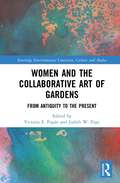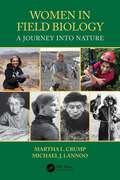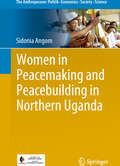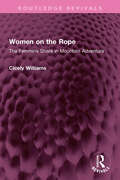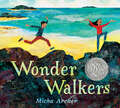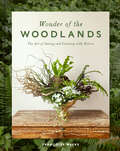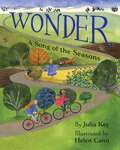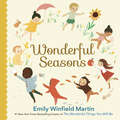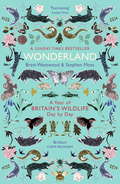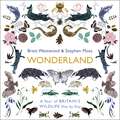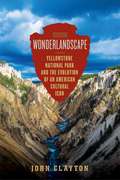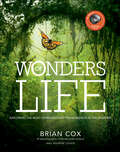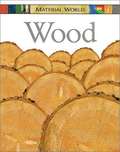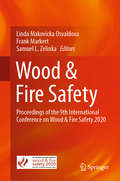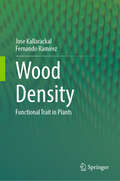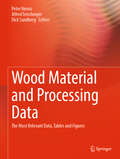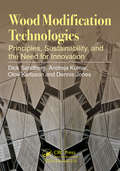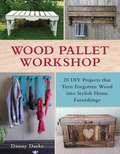- Table View
- List View
Women and the Collaborative Art of Gardens: From Antiquity to the Present (Routledge Environmental Literature, Culture and Media)
by Victoria E. Pagán Judith W. PageWomen and the Collaborative Art of Gardens explores the garden and its agency in the history of the built and natural environments, as evidenced in landscape architecture, literature, art, archaeology, history, photography, and film. Throughout the book, each chapter centers the act of collaboration, from garden clubs of the early twentieth century as powerful models of women’s leadership, to the more intimate partnerships between family members, to the delicate relationship between artist and subject. Women emerge in every chapter, whether as gardeners, designers, owners, writers, illustrators, photographers, filmmakers, or subjects, but the contributors to this dynamic collection unseat common assumptions about the role of women in gardens to make manifest the significant ways in which women write themselves into the accounts of garden design, practice, and history. The book reveals the power of gardens to shape human existence, even as humans shape gardens and their representations in a variety of media, including brilliantly illuminated manuscripts, intricately carved architectural spaces, wall paintings, black and white photographs, and wood cuts. Ultimately, the volume reveals that gardens are best apprehended when understood as products of collaboration. The book will be of interest to scholars and students of gardens and culture, ancient Rome, art history, British literature, medieval France, film studies, women’s studies, photography, African American Studies, and landscape architecture.
Women in Field Biology: A Journey Into Nature
by Michael J. Lannoo Martha L. CrumpWomen are contributing to disciplines once the sole domain of men. Field biology has been no different. The history of women field biologists, embedded in a history largely made and recorded by men, has never been written. <p><p>Compilations of biographies have been assembled, but the narrative—their story—has never been told. In part, this is because many expressed their passion for nature as writers, artists, collectors, and educators during eras when women were excluded from the male-centric world of natural history and science. The history of women field biologists is intertwined with men’s changing views of female intellect and with increasing educational opportunities available to women. Given the preponderance of today’s professional female ecologists, animal behaviorists, systematists, conservation biologists, wildlife biologists, restoration ecologists, and natural historians, it is time to tell this story—the challenges and hardships they faced and still face, and the prominent role they have played and increasingly play in understanding our natural world. <p><p> For a broader perspective, we profile selected European women field biologists, but our primary focus is the journey of women field biologists in North America. Each woman highlighted here followed a unique path. For some, personal wealth facilitated their work; some worked alongside their husbands. Many served as invisible assistants to men, receiving little or no recognition. Others were mavericks who carried out pioneering studies and whose published works are still read and valued today. <p><p>All served as inspiration and proved to the women who would follow that women are as capable as men at studying nature in nature. Their legacy lives on today. The 75 female field biologists interviewed for this book are further testament that women have the intellect, stamina, and passion for fieldwork.
Women in Peacemaking and Peacebuilding in Northern Uganda (The Anthropocene: Politik—Economics—Society—Science #22)
by Sidonia AngomThe book analyses the two decades of the brutal civil war of northern Uganda. The author modified Lederach's peacebuilding framework to include peacemaking to bring out the argument that women and men make significant contributions to the peace processes and point out women’s position as top leadership actors. The book uncovers the under-emphasised role of women in peacemaking and building. From grassroots to national level, women were found to have organised themselves and assumed roles as advocates, negotiators and mobilisers. The actions by women became evident at the stalemated Juba peace talks when women presented the Peace Torch to the peace negotiating teams who on the occasion shook hands for the first time and peace was ushered in. Their initiatives and non-violent actions offer lessons to resolve civil conflicts in Africa. The book recommends that women should undergo relevant training in times of peace as this would make them more effective in times of need.
Women in the Environmental Sciences (Major Women in Science #10)
by Shaina IndovinoWomen have made major contributions to science throughout history, including in the environmental sciences. Learn about the lives of some of the most amazing women in environmental science, from Rachel Carson to Lena Ma, as well as their exciting and important work. Discover what it takes to work in the environmental sciences. Find out about the opportunities for women in the field. Read Women in the Environmental Sciences to see if following in the footsteps of the many brilliant women who have made their mark in environmental science is something you want to do.
Women on the Rope: The Feminine Share in Mountain Adventure (Routledge Revivals)
by Cicely WilliamsFirst published in 1973, Women on the Rope provides the first consecutive story of the ‘feminine share in mountain adventure’, a share which has grown from tiny beginnings in 1808 to a level at which women have won their place at Everest expeditions. Cicely Williams provides a book which combines exact and detailed knowledge of a little-known chapter of human enterprise with that zest for life and love of mountains that have brought her so many friends. This is a book for mountaineers, for social historians, and for the fireside connoisseur of good storytelling.
Wonder Walkers
by Micha ArcherA Caldecott Honor winner! Micha Archer's gorgeous, detailed collages give readers a fresh outlook on the splendors of nature.Cover may vary. When two curious kids embark on a "wonder walk," they let their imaginations soar as they look at the world in a whole new light. They have thought-provoking questions for everything they see: Is the sun the world's light bulb? Is dirt the world's skin? Are rivers the earth's veins? Is the wind the world breathing? I wonder . . . Young readers will wonder too, as they ponder these gorgeous pages and make all kinds of new connections. What a wonderful world indeed!
Wonder of the Woodlands: The Art of Seeing and Creating with Nature
by Françoise WeeksBring home the charm of the wild woods with creative botanical arrangements that are so much more than just bouquets of flowers.Containers lined with bark to replace ordinary glass vases. A bed of moss to cushion a vibrant spring arrangement. Ever-changing wreaths to showcase acorns, branches, lichen, twining vines, and delicate ferns throughout the year. A cloche holding an arrangement of dried mushrooms that might have come out of a fairytale. In this gorgeous celebration of the woodlands, renowned floral designer Françoise Weeks offers all the ways, from simple to complex, that you can bring the wildness and wonder of the forest to your indoor arrangements. Each chapter of Wonder of the Woodlands features the materials Françoise uses most—barks and logs; acorns and seeds; ferns, branches, moss, and lichen—and showcases how she builds her unique, beautiful arrangements, which last far longer than a vase of cut flowers. Inside are also Françoise&’s insights on seeking out the most unique natural materials for arrangements, and how to responsibly forage or source them in a shop. And you&’ll find her tips on how to reuse materials so you can enjoy lots of different arrangements without increasing your environmental impact. Bursting with images of nature and suggestions for weaving that magic into your interiors, Wonder of the Woodlands is a celebration of arrangements that are inspired by a walk through the trees. With stunning photography of wild and wonderful wreaths, table arrangements, wall decor, and more, you can re-create the peaceful majesty of spending time in the forest in your own home.
Wonder: A Song of the Seasons
by Julia KeyWonder is a beautifully illustrated rhyming picture book that aims to heighten awareness of and interest in the natural world. The reader is invited to follow and share in the adventure of two young girls who cycle together from dawn to dusk, passing through an unfolding series of landscapes representing the cycle of the seasons. It is a glimpse of the world through the eyes of a child, and an encouragement to stop and look—indeed to use all of our senses to appreciate and fully engage with nature. It also seeks to capture something of the mystery and magic of creation. Wonder is a true visual feast, thanks to its captivating and intricate illustrations by award-winning artist Helen Cann. It is a book designed to be read aloud, with a musical quality and soothing repetitive rhythms that are sure to appeal to young ears.
Wonderful Seasons
by Emily Winfield MartinCelebrate the seasons with this original board book by Emily Winfield Martin--perfect for baby showers and fans of the New York Times Bestseller, The Wonderful Things You Will Be!From Springtime fun to cozy Winter, this book captures the adorableness of a diverse cast of babies in the beauty of all four seaons. With simple text and irresistable art, this lighthearted book will bring a smile to parents and the youngest readers alike.
Wonderland: A Year of Britain's Wildlife, Day by Day
by Stephen Moss Brett Westwood'Vibrant, fascinating, poetic - a year in living things: all the things we love, all the things we wish we could, all the little things we step over and never know - the best of British wildlife from two superb naturalists and writers' CHRIS PACKHAMFrom blackbirds, beavers and beetles to tawny owls, natterjack toads and lemon slugs. Every day of the year, winter or summer, in every corner of the British Isles, there's plenty to see if you know where - and how - to look. From encounters with the curious black redstart, which winters on our rocky coasts, to the tiny green snowdrop shoots that are the first sign that spring might be round the corner. And from the blossom-time and dawn choruses of April and May into the abundant noisiness of summer, where days start with hawker dragonflies and drowsy bumblebees and end with glow-worms and ghost moths; to autumn when in the early morning mist of London's Richmond Park male red deer lock horns in competition for a mate.Nature is always full of surprises - whether it's the strange behaviour of clothes moths or the gruesome larder of the strike. Distilling two lifetimes' knowledge, expert insight and enthusiasm, award-winning authors and passionate naturalists Brett Westwood and Stephen Moss take us through the year, day by day, sharing the unexpected delights that we can experience in our skies, beaches, rivers, fields, forests and back gardens. There are all kinds of adventures waiting on your doorstep, any day of the year, all you need is Wonderland.
Wonderland: A Year of Britain's Wildlife, Day by Day
by Stephen Moss Brett WestwoodA SUNDAY TIMES BESTSELLER'Vibrant, fascinating, poetic - a year in living things: all the things we love, all the things we wish we could, all the little things we step over and never know - the best of British wildlife from two superb naturalists and writers' CHRIS PACKHAMFrom blackbirds, beavers and beetles to tawny owls, natterjack toads and lemon slugs. Every day of the year, winter or summer, in every corner of the British Isles, there's plenty to see if you know where - and how - to look. From encounters with the curious black redstart, which winters on our rocky coasts, to the tiny green snowdrop shoots that are the first sign that spring might be round the corner. And from the blossom-time and dawn choruses of April and May into the abundant noisiness of summer, where days start with hawker dragonflies and drowsy bumblebees and end with glow-worms and ghost moths; to autumn when in the early morning mist of London's Richmond Park male red deer lock horns in competition for a mate.Nature is always full of surprises - whether it's the strange behaviour of clothes moths or the gruesome larder of the strike. Distilling two lifetimes' knowledge, expert insight and enthusiasm, award-winning authors and passionate naturalists Brett Westwood and Stephen Moss take us through the year, day by day, sharing the unexpected delights that we can experience in our skies, beaches, rivers, fields, forests and back gardens. There are all kinds of adventures waiting on your doorstep, any day of the year, all you need is Wonderland.
Wonderland: A Year of Britain's Wildlife, Day by Day
by Stephen Moss Brett Westwood'Vibrant, fascinating, poetic - a year in living things: all the things we love, all the things we wish we could, all the little things we step over and never know - the best of British wildlife from two superb naturalists and writers' CHRIS PACKHAMA life-affirming nature diary - with something amazing to see and experience on every day of the year -from award-winning authors and Springwatch experts Brett Westwood and Stephen Moss.From blackbirds, beavers and beetles to tawny owls, natterjack toads and lemon slugs. Every day of the year, winter or summer, in every corner of the British Isles, there's plenty to see if you know where - and how - to look. From encounters with the curious black redstart, which winters on our rocky coasts, to the tiny green snowdrop shoots that are the first sign that spring might be round the corner. And from the blossom-time and dawn choruses of April and May into the abundant noisiness of summer, where days start with hawker dragonflies and drowsy bumblebees and end with glow-worms and ghost moths; to autumn when in the early morning mist of London's Richmond Park male red deer lock horns in competition for a mate.Nature is always full of surprises - whether it's the strange behaviour of clothes moths or the gruesome larder of the strike. Distilling two lifetimes' knowledge, expert insight and enthusiasm, award-winning authors and passionate naturalists Brett Westwood and Stephen Moss take us through the year, day by day, sharing the unexpected delights that we can experience in our skies, beaches, rivers, fields, forests and back gardens. There are all kinds of adventures waiting on your doorstep, any day of the year, all you need is Wonderland. (P)2017 John Murray Press
Wonderlandscape: A Cultural History Of Yellowstone National Park
by John ClaytonAn evocative blend of history and nature writing that tells the story of Yellowstone’s evolving significance in American culture through the stories of ten iconic figures. Yellowstone is America's premier national park. Today is often a byword for conservation, natural beauty, and a way for everyone to enjoy the great outdoors. But it was not always this way. Wonderlandscape presents a new perspective on Yellowstone, the emotions various natural wonders and attractions evoke, and how this explains the park's relationship to America as a whole. Whether it is artists or naturalists, entrepreneurs or pop-culture icons, each character in the story of Yellowstone ends up reflecting and redefining the park for the values of its era. For example, when Ernest Thompson Seton wanted to observe bears in 1897, his adventures highlighted the way the park transformed from a set of geological oddities to a wildlife sanctuary, reflecting a nation was concerned about disappearing populations of bison and other species. Subsequent eras added Rooseveltian masculinity, democratic patriotism, ecosystem science, and artistic inspiration as core Yellowstone hallmarks. As the National Park system enters its second century, Wonderlandscape allows us to reflect on the values and heritage that Yellowstone alone has come to represent—how it will shape the America's relationship with her land for generations to come.
Wonders of Life: Exploring the Most Extraordinary Phenomenon in the Universe (Wonders Series)
by Andrew Cohen Brian CoxIn Wonders of Life: Exploring the Most Extraordinary Force in the Universe, the definitive companion to the Discovery Science Channel series, Professor Brian Cox takes us on an incredible journey to discover the most complex, diverse, and unique force in the universe: life itself.Through his voyage of discovery, international bestselling author Brian Cox explains how the astonishing inventiveness of nature came about and uncovers the milestones in the epic journey from the origin of life to our own lives, with beautiful full-color illustrations throughout. From spectacular fountains of superheated water at the bottom of the Atlantic to the deepest rainforest, Cox seeks out the places where the biggest questions about life may be answered: What is life? Why do we need water? Why does life end?Physicist and professor Brian Cox uncovers the secrets of life in the most unexpected locations and in the most stunning detail in this beautiful full-color volume.
Wonders of the Rain Forest
by Janet CraigDiscusses the animals and plants which give such color and beauty to tropical rain forests and jungles.
Wonders: Spectacular Moments in Nature Photography
by California Academy of Sciences Rhonda RubensteinNature is full of fleeting wonders. This breathtaking collection of nature photography reveals rare creatures, transports us to distant landscapes, and captures uncommon moments of drama and beauty in the natural world. From a heart-pounding shot of the Wildebeest Migration to a glimpse of the elusive Pampas cat, each image tells a story about the diversity and grandeur of life on earth. Bold, surprising, and jaw-droppingly beautiful, these photographs are all winners of the California Academy of Sciences' BigPicture Natural World Photography Competition. With more than 100 photographs and captions explaining the scientific phenomena and photographic techniques behind each picture, this book will captivate nature lovers, science enthusiasts, photographers, and adventurers.
Wood
by Claire LlewellynSoft, warm, heavy, slimy. . . which of these words describe metal or plastic, rubber or wood? This series covers them all -- with big colorful photographs, "Fascinating Facts, " and easy "Try This" experiments that introduce simple science concepts in a fun and engaging way, and show how each material is produced, transformed for everyday use, and impacts the environment. That paper plate in the lunchroom will never seem the same again once readers really get to know their Material World!
Wood
by Rebel WilliamsA daughter explains the processes her and her father went through to build their dog house.
Wood & Fire Safety: Proceedings of the 9th International Conference on Wood & Fire Safety 2020
by Linda Makovicka Osvaldova Frank Markert Samuel L. ZelinkaThis proceedings volume presents new scientific works of the research workers and experts from the field of Wood Science & Fire.It looks into the properties of various tree species across the continents affecting the fire-technical properties of wood and wood-based materials, its modifications, fire-retardant methods and other technological processes that have an impact on wood ignition and burning. The results of these findings have a direct impact on Building Construction and Design describing the fire safety of wooden buildings, mainly large and multi-story ones. The results of these experiments and findings may be applied, or are directly implemented into Fire Science, Hazard Control, Building Safety which makes the application of wood and wood materials in buildings possible, while maintaining strict fire regulations.One part of the contributions focuses on the symbiosis of the material and the fire-fighting technologies. Wood burning has its own specific features, therefore, the fire protection technologies need to be updated regularly. It also includes the issue of the intervention of fire-fighting and rescue teams in the fires of wooden buildings. Presentations deal with the issue of forest fires influenced by the climate changes, relief, fuel models based on the type and the age of the forest stand.
Wood Density: Functional Trait in Plants
by Fernando Ramírez Jose KallarackalRecent research has shed light on the crucial role of wood density, a fundamental physical property, as a functional trait. This means wood density isn't just about how much a piece of wood weighs, but how it influences a plant's entire strategy for survival and growth. While variations exist between individual species, a surprising trend has emerged: the majority of this variation can be traced back to a plant's genus or even family. This strong phylogenetic signal indicates that wood density is a deeply ingrained characteristic, shaped by a plant's evolutionary history. This newfound understanding allows us to leverage wood density as a taxon-based functional trait. By considering the typical wood density of a plant group (like a genus or family), we can improve models and predictions related to various ecological and functional aspects in forests and plantations. Over the past couple of decades, scientists have been actively exploring the connections between wood density and a wide range of plant functions. Denser wood is often linked to slower growth rates, delayed reproduction, and increased mechanical strength. It also influences a plant's ability to transport water, resist death (mortality rate), and manage internal water balance (water potential). Additionally, wood density is closely tied to physiological aspects such as gas exchange and xylem hydraulic conductance, which are crucial for nutrient and water movement. Wood density is also an important parameter to determine the carbon sequestration capacity of a tree or vegetation, thus important in climate change research. This proposed book will delve into these fascinating connections, highlighting how wood density acts as a key player in shaping the lives of plants and the overall health of forest ecosystems.
Wood Hicks and Bark Peelers: A Visual History of Pennsylvania’s Railroad Lumbering Communities; The Photographic Legacy of William T. Clarke (Keystone Books)
by Ronald E. Ostman Harry LittellIn Wood Hicks and Bark Peelers, Ronald E. Ostman and Harry Littell draw on the stunning documentary photography of William T. Clarke to tell the story of Pennsylvania’s lumber heyday, a time when loggers serving the needs of a rapidly growing and globalizing country forever altered the dense forests of the state’s northern tier.Discovered in a shed in upstate New York and a barn in Pennsylvania after decades of obscurity, Clarke’s photographs offer an unprecedented view of the logging, lumbering, and wood industries during the late nineteenth and early twentieth centuries. They show the great forests in the process of coming down and the trains that hauled away the felled trees and trimmed logs. And they show the workers—cruisers, jobbers, skidders, teamsters, carpenters, swampers, wood hicks, and bark peelers—their camps and workplaces, their families, their communities. The work was demanding and dangerous; the work sites and housing were unsanitary and unsavory. The changes the newly industrialized logging business wrought were immensely important to the nation’s growth at the same time that they were fantastically—and tragically—transformative of the landscape. An extraordinary look at a little-known photographer’s work and the people and industry he documented, this book reveals, in sharp detail, the history of the third phase of lumber in America.
Wood Hicks and Bark Peelers: A Visual History of Pennsylvania’s Railroad Lumbering Communities; The Photographic Legacy of William T. Clarke (Keystone Books)
by Ronald E. Ostman Harry LittellIn Wood Hicks and Bark Peelers, Ronald E. Ostman and Harry Littell draw on the stunning documentary photography of William T. Clarke to tell the story of Pennsylvania’s lumber heyday, a time when loggers serving the needs of a rapidly growing and globalizing country forever altered the dense forests of the state’s northern tier.Discovered in a shed in upstate New York and a barn in Pennsylvania after decades of obscurity, Clarke’s photographs offer an unprecedented view of the logging, lumbering, and wood industries during the late nineteenth and early twentieth centuries. They show the great forests in the process of coming down and the trains that hauled away the felled trees and trimmed logs. And they show the workers—cruisers, jobbers, skidders, teamsters, carpenters, swampers, wood hicks, and bark peelers—their camps and workplaces, their families, their communities. The work was demanding and dangerous; the work sites and housing were unsanitary and unsavory. The changes the newly industrialized logging business wrought were immensely important to the nation’s growth at the same time that they were fantastically—and tragically—transformative of the landscape. An extraordinary look at a little-known photographer’s work and the people and industry he documented, this book reveals, in sharp detail, the history of the third phase of lumber in America.
Wood Material and Processing Data: The Most Relevant Data, Tables, and Figures
by Dick Sandberg Peter Niemz Alfred TeischingerThe book is intended for professionals in the field of materials science, construction technology and operational design of new facilities. Characteristic values for the calculation, project planning and process optimization are often important for the engineer working in the project planning of plants. Therefore, characteristic values for solid wood from different continents and for wood-based materials and modified wood are compiled in tabular form. Important adhesives and coating materials complete the collection of characteristic values. Standards from Europe, the USA, Russia and China are also listed. Information on material consumption, energy consumption and material utilization are also included (sawn wood, wood based material, pulp and paper). Other important information and a list of specialist books complete the data collection. The data supplement the knowledge in existing specialist books and compendiums in the field of wood science and wood technology, with a large numberof specific details that are only briefly compiled in specialist articles or specialist books.
Wood Modification Technologies: Principles, Sustainability, and the Need for Innovation
by Dennis Jones Andreja Kutnar Dick Sandberg Olov KarlssonThe market for durable products using modified wood has increased substantially during the last few years. This is partly because of the restriction on the use of toxic preservatives due to environmental concerns, and to lower maintenance cost and time. Furthermore, as sustainability becomes a greater concern, the environmental impact of construction and interior materials is factored in planning by considering the whole life cycle and embodied energy of the materials used. Wood is modified to improve its intrinsic properties, enhance the range of applications of timber, and to acquire the form and functionality desired by engineers without calling the environmental friendliness into question. Wood modification processes are at various stages of development, and the challenges faced in scaling up to industrial applications differ. The aim of this book is to put together the key elements of the changes of wood constituents and the related changes in wood properties of modified wood. Further, a selection of the principal technologies implemented in wood modification are presented. This work is intended for researchers, professionals of timber construction, as well as students studying the science of materials, civil engineering and architecture. This work is not exhaustive, but intends to deliver an outline of the scientific disciplines necessary to apprehend the technologies of wood modification and its behavior during treatment, as well as during its use.
Wood Pallet Workshop: 20 DIY Projects that Turn Forgotten Wood into Stylish Home Furnishings
by Danny DarkeWooden shipping pallets have found an unlikely second life: beautiful, handcrafted home décor without the designer price. The DIY market has long been drawn to refurbishing furniture and interior design on a budget, but easily accessible wood pallets have opened up all-new and inspiring ways to personalize a home in an eco-friendly, low-cost way.Until recently, upcycling required crafters to hunt for goods and furniture at yard sales and online, and many refurbishing books could only offer tips for specific pieces. With wooden pallets, the scope of the project is boundless, and warehouses and stores are happy to give them away for free. What was once a scavenger hunt and test of skill for experienced DIYers can now be an easy weekend project for even the newest of crafters.Wood Pallet Workshop will be a book of inspiration as well as a hardworking instructional guide for an array of projects. With 20 easy-to-follow designs ranging from coffee tables and wine racks to decorative wall art and step-by-step photos, this book will be a go-to instructional guide for DIYers looking for simple and creative ways to decorate their homes.
